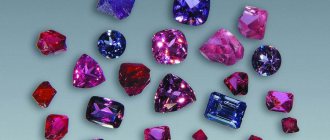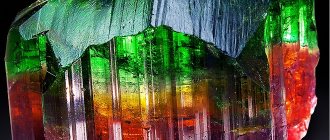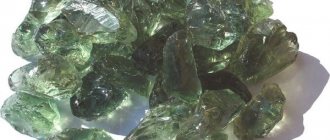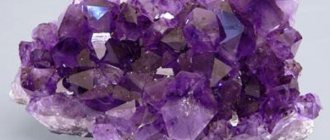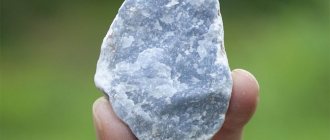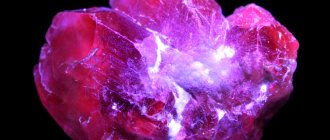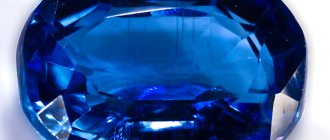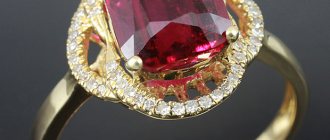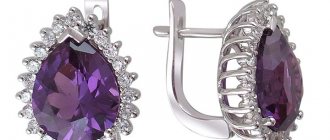Spinel is a red semi-precious stone. In the past, it was often confused with ruby, since they cannot be distinguished from each other by eye. Only spectral analysis made it possible to establish that these are two completely different minerals. So, what properties does spinel stone have, who is it suitable for and how to choose and care for it correctly?
Historical reference
The famous traveler Marco Polo, who visited the Pamirs in the 13th century, first mentioned spinel as a jewelry stone. Spinel began to be mined in the 9th century in the southwest of the Pamirs in the Kuhilale deposit.
The stone was then often confused with ruby and corundum, so Marco Polo called the spinel deposit “ruby mines.”
With the development of science, the stone was identified as a separate group of minerals with unique physical properties. Despite this, spinel was often used in ancient times. It has always been one of the rarest and most expensive minerals.
The stone served as decoration and a symbol of power for representatives of Germany, Great Britain, Russia, and France:
- The famous “Monomakh's Cap” is decorated with spinel, and not with rubies, as was previously believed.
- The crown of Catherine the Great is inlaid with this stone.
- The Wittelbach Crown was decorated in 1830 with teardrop-shaped spinels. Previously it was assumed that these were rubies.
- The stone has had different names over the centuries of its existence: coelonite, noble spinel, picotite, lal, rubicel.
History of the stone
What is spinel? This is the name given to a beautiful stone similar to a ruby, the crystals of which are pointed like thorns. Spina is Latin for "spike", from which the German word Spinell may have been derived. There is another interpretation of the origin of the name - from the Greek word “spinos” (“to shine”). After cutting, the mineral casts bright reflections.
This gem has been mined for a long time, but the first written information about it appeared only in the 13th century thanks to the famous traveler Marco Polo. He described in detail the stone and the conditions of its extraction in the Pamir Mountains, said that the deposits have been developed since the 9th century , but called them “ruby mines”, since spinel is very similar to ruby.
During the time that this mineral has been known to people, it has received various names from them:
- lal (lall);
- coelonite;
- picotite;
- Rubicel.
This gem is very difficult to visually distinguish from other gemstones due to its beauty, color saturation, transparency and hardness. This has only recently become possible thanks to advances in technology and chemical analysis. Only a century and a half ago, the mineral received its official name and deserved place among stones.
It turned out that many samples of rubies stored in collections, museums, and treasuries of rulers are not rubies, but spinels.
The large rubies on the royal and royal crowns also turned out to be fake. Large gems were chosen for them, and real rubies are rarely of this size.
After careful examination in the early 20th century , one of the greatest British Crown Jewels, the Black Prince's Ruby, was found to be a fine example of 170-carat spinel.
“Timur’s Ruby,” now owned by the British crown, is also an “imposter” spinel weighing 361 carats .
This gem was also considered a ruby in the crown of the Russian Empress Catherine II. The weight of the stone is 398.72 carats . The crown of Catherine the Great, a true work of jewelry art, now adorns the Diamond Fund of Russia.
The largest “ruby”, which turned out to be a noble spinel, shines on the crown of the Persian Shahs. This 500-carat luxury stone was once a treasure of the Mughal Empire.
Many royal and royal regalia are decorated with these beautiful gems, including the Monomakh Cap (on it, along with a ruby and other precious stones, three spinel stones shine).
Mining locations
Large (5x3.5x3.2cm) octahedral crystal of dark blue spinel on marble.
Mogok, Mandalay, Burma From time immemorial, the mineral spinel was mined in the Pamirs. It was here that a record stone sample was discovered in 1985 - a crystal weighing more than five kilograms. This happened in the Kuhi-Lal (Ruby Mountain) deposit in the territory of then Soviet Tajikistan. In the Russian Federation, gem mining is carried out in the Republic of Yakutia, as well as in Altai and south of Lake Baikal.
The leaders in supplying the mineral to the world market are:
- Sri Lanka;
- India;
- Thailand;
- Afghanistan;
- Myanmar;
- Australia.
Almost everywhere it accompanies ruby deposits, which added even more confusion before the invention of chromatography. The most beautiful and expensive spinel specimens are mined in Myanmar. Sri Lanka boasts unique blue stones. Australian deposits are quite rich, but the crystals there are black and are used mainly for decoration or industrial purposes; their price is low.
The story of the stone
For many centuries, spinel “passed off” as… a ruby.
Therefore, some rubies in the royal treasuries later turned out to be spinels. Of course, this happened by accident, namely because the spinel was mistakenly considered a ruby. However, despite this, the precious stone served as a worthy gift to the kings and rulers of this world. In ancient times, all red stones were called carbuncles (from the Latin carbunculus - “coal”). Among them were rubies, garnets (pyropes, almandines) and spinels. In the 9th – 10th centuries. These stones began to be distinguished into yakhonts (red - rubies, blue - sapphires) and lalas, that is, spinels.
According to one version, spinel received the name “lal” from the name of Mount Kuh-i-lal (“Mountain Lal”) in the Badakhshan region, where a large deposit of the gem was discovered. By the way, rubies were also found in abundance here. It was at this time that gems were divided into yakhonts and lalas, considering the latter to be a less valuable variety of ruby.
And so, spinel is a modern name, but it is also quite old. Why was it called that? Apparently, as mineralogists suggest, this came from the pointed shape of the gem crystals (from the Latin spina - “thorn”). There is another version - the stone received its name due to its extraordinary shine (Greek “spintes” - “spark”).
In Rus', stones were called lalas for their beautiful scarlet color. In Western Europe, spinel was also appreciated; it became known there in the 13th century after the travel of Marco Polo. A Genoese merchant visited the Pamirs and visited ruby mines; he wrote that the stones were mined only with the permission of the ruler of Badakhshan, who sold them for gold. In his notes, Marco Polo referred to spinel as “balash” or Badakhshan lal. It was only in 1783 that ruby and spinel were recognized as different minerals.
A beautiful stone with an unusual shine adorned many royal treasuries and regalia. And it doesn’t matter that it was mistaken for a ruby. And when the truth triumphed, the beauty and value of the gem did not suffer at all.
The largest spinel is the property of the Iranian treasury. It is known as the spinel from Samaria (in the 9th – 8th centuries BC, the capital of the Kingdom of Israel). This is a blood-red stone weighing 500 carats (100 grams), 5.5 cm wide.
The second largest jewel adorns the Great Imperial Crown of the Russian Empire, which is exhibited in the Armory Chamber of the Moscow Kremlin. The gem, weighing 398.72 carats, is red in color and is pure and transparent. It was purchased by one of the Russian diplomats in Beijing under Tsar Alexei Mikhailovich.
In 1724, he adorned the first Russian crown, which was used to crown Catherine I. In 1762, the spinel adorned the new crown of the Russian Empire, and Catherine II was crowned with it. Legendary stones occupy places of honor in the British Crown and in the Louvre. Beautiful gems adorned not only royal attire, but also religious objects, as well as jewelry. An example is the altar composition “Holy Trinity”, made by French masters.
So what kind of stone is this noble spinel?
Physical and chemical properties
MgAl2O4 - spinel has a high degree of isomorphism of the metals it contains: some of the magnesium and aluminum ions can be replaced by metal ions of comparable size without changing the basic properties.
Magnesium ions are replaced by iron, sometimes zinc, and some of the aluminum is replaced by iron or chromium. Without affecting the basic properties in any way, this determines the color of the mineral.
| Formula | MgAl2O4 |
| Color | Colorless, red, pink, blue, green, purple, yellow |
| Shine | Glass |
| Transparency | Transparent to translucent |
| Hardness | 7,5—8 |
| Cleavage | Imperfect |
| Kink | Conchoidal |
| Density | 3.57—3.72 g/cm³ |
Spinel varieties
Among the very diverse varieties of spinel are:
- Noble spinel - transparent spinel crystals, painted in beautiful colors (if thick red - then they call it ruby spinel, if orange-red - rubicell, if pink - ruby-bale, if purple - oriental amethyst), also noble spinel can be called blue spinel ( or sapphire-spinel), alexandrite-effect spinel (blue in daylight, purple-violet in incandescent light), and blue and green spinel. The main deposits of noble spinel are the islands of Ceylon, Borneo, and India. Along with ruby, noble pink spinel is mined at the high-mountain Kugelal (Kuh-i-lal) deposit (Pamir, Tajikistan).
Rubicell
- Ordinary spinel, pleonast or ceylonite - spinel of intermediate composition between spinel itself and hercynite - (Mg,Fe)Al2O4. Specific gravity 3.7 - 4.4. Microhardness 1.666 - 1.765 at a load of 100 g. Color dark green to black, less often blue-black and dark brown. Melting point 1275-1360 °C. Decomposes from the action of HF and H2SO4. Occurs frequently, sometimes in very large crystals. In Russia there are many pleonastas in the Urals, in the Shishim and Nazyam mountains.
Pleonastus
- Chrome spinel - picotite, black, part of the aluminum is replaced by chromium.
Picotite
- Ganit is a zinc spinel where magnesium is replaced by iron and zinc.
Ganit
- Chlorine spinel - Mg(Al,Fe)2O4, intermediate between spinel and magnesioferrite; the color is bright green.
Chlorspinel
- Automolite is intermediate between spinel and ganite.
Automolite
- Surovik is a purple or bluish-gray spinel.
Surovik
Varieties and colors
Spinel is a fairly large group of minerals, which are complex oxides. Of these, only a small part are precious or semi-precious stones, called noble spinel. Their value depends on transparency, purity, size, but most of all - on color.
Color is the main criterion for evaluating a spinel stone:
- Watery-transparent minerals are similar to diamonds, but after cutting they are inferior to diamonds in the play of light on the edges.
- Ruby spinel is very similar to ruby. The red color of both gems is given by chromium impurities. Of all the varieties of this mineral, the bright red spinel stone is the most expensive.
- Bale ruby is a pink-red variety. The admixture of manganese gives purple shades.
- Almandine spinel - violet-red color.
- Rubicel - orange-red and yellow shades. Yellowness appears due to iron impurities.
- Sapphire - blue and light blue shades. It is found very rarely in nature. High quality, deep blue specimens cost almost as much as ruby.
- Gano-spinel is blue, sometimes with a purple tint.
- Chlorospinel is a bright green color due to the admixture of chlorine. Single samples of it were found in the Southern Urals.
- Pleonast (ceylonite) - dark green with a brown tint, brown, black. Contains a lot of iron, opaque or translucent. This variety is the most common. It is mined in the Urals and Yakutia. There are large crystals - up to 30 cm .
- Picotite is a dark (chrome) spinel. The color comes from chromium ions that have replaced aluminum ions. “Black ruby” is what this variety is sometimes called.
- Hercynite is black with a dark green tint. Magnesium is replaced by iron. In Yakutia, crystals up to 12 cm were found.
Areas of application
Spinel
Opaque pleonast - ornamental; specimens with purity and beautiful shades can be used as a noble mineral. Thanks to the controversial attitude towards black and dark stones (partly anachronism), prices for products are more affordable. Original and large crystals are valued by collectors.
Picotite is often used as an ornamental material; it can be confused with black sapphires or garnets. Picotite beads can be purchased from 5-15 thousand, often used in bracelets, beads and as inserts in more complex jewelry.
Red spinel ring
High quality spinel is an expensive jewelry stone, second only to diamonds and rubies. When cut, spinel can surpass ruby in saturation, depth and brilliance, but is inferior in hardness, smoothing out in the corners and on the edges of the faces. Used to create top-class jewelry.
Dark varieties of gems may seem gloomy in the absence of sunlight, while light varieties look impressive even in insufficient lighting without losing their shine. The price of a stone is influenced not only by color, but also by uniformity, transparency, purity, size (the price per 1 carat increases with the size of the stone), processing, and its historical value. The market value of noble spinel ranges from 25 dollars per carat (ganospinel) to 500 (red spinels and sapphires).
Cut - brilliant or step. When asterism appears (an optical effect - the appearance of a star-shaped figure when illuminated), which looks better with a convex surface, it is processed with a cabochon.
How to distinguish from a fake
It is almost impossible to independently distinguish natural spinel from a fake. Stone authenticity factors:
- The main criterion is the price of the stone: the cost of noble spinel starts from $25 per carat , and pure bright red or blue specimens - from several hundred dollars per 1 carat . If the price of a stone is below $25 , you can suspect a fake.
- Certificate of quality.
- Customs examination indicating the country of origin of the crystal.
If you were given a spinel as a gift or inherited it without individual documents, you can examine the stone for authenticity at home. To do this you should:
- Carefully examine the mineral. Artificial has a very attractive appearance, impeccable cleanliness and uniform transparency.
- Explore with a magnifying glass. If the color is uneven and there are inclusions, then the stone is most likely genuine. In addition, it should be taken into account that bubble inclusions in a natural gem are of identical color, while in a fake they are lighter or colorless.
- For red spinel, you can also use a popular household method: place the crystal in a glass container - its inside will turn reddish.
An accurate examination of the authenticity of the stone can be done in an expert laboratory.
How to recognize a fake
Spinel, twin crystal ~ 5 mm.
in pyrrhotite. Kuhilal, Nagorno-Badakhshan, Tajikistan. Photo: V. Levitsky The stone is used not only in jewelry, but also in industry. As always in such cases, scientists began to look for a cheaper alternative. It became synthetic spinel, which is produced in laboratories using the Verneuil method. Such stones, produced in huge volumes, have replaced inferior varieties of natural gems on the market.
Some of the most successful samples go into jewelry making. The price of such spinel is significantly lower than that of natural spinel. Some unscrupulous sellers take advantage of this by passing off synthetics as natural stones. The problem here is not only the overpayment, but also the fact that artificial crystals lack the magical and healing properties of the original.
When purchasing a stone, you should pay attention to the price. The cheapest natural spinel, greenish, pink or pale blue, cannot cost less than $25 per carat. The cost of ruby and sapphire varieties starts at $500.
You should purchase gems only from certified stores. Such expensive minerals should always be sold with a passport and quality certificate. It needs to be studied carefully. Laboratory samples should have the word “synthetic” there, or the gem will simply be called “imitation”, “identical to natural”, etc.
Spinel refining
Natural spinel is not refined due to the unique properties of these stones. However, methods for growing artificial crystals have been developed. Therefore, specimens of synthetic spinel are often found on sale, which are difficult to distinguish from real minerals of natural origin using standard diagnostic methods. When purchasing expensive spinel, you must ensure that you have an expert opinion issued by one of the independent gemological laboratories. The lack of refining makes spinel stand out from other precious stones.
Synthetic Spinel (Artificial)
Synthetic spinel
Modern science has made it possible to produce analogues of natural gems, including spinel. Surprisingly, the method of growing synthetic spinel was discovered completely by accident. Scientists tried to get blue sapphire. To do this, they used the famous Verneuil method. However, what was taken out of the apparatus was not a sapphire at all, but a spinel crystal, which had a cubic shape. It was this incident that laid the foundation for the creation of an artificial mineral.
Spinel is easily obtained by fusing and sintering mixtures of appropriate pure oxides at 1400–1920 °C. The presence of mineralizers significantly reduces the temperature of its formation. The jewelry variety of spinel is synthesized using the Verneuil method: pure Al2O3 and MgO powders are melted after being treated with a detonating gas flame at a temperature of 2500°C, the melt in the form of drops falls to the bottom of the furnace, where a refractory candle with a spinel seed is placed; a monocrystal gradually grows in the form of a bulk. The formation of spinel in slags and in magnesite bricks of an electric melting furnace is known.
Spinel is formed by heating muscovite, glauconite, montmorillonite, bentonite, and chlorite above 1000 °C, by fusing clay, bauxite, or corundum with MgO at 1700, 1850, 2000 °C, respectively.
Today you can get spinel of any shade by adding various impurities. For example, blue shades are obtained using cobalt. But these specimens have a reddish tint, which cannot be found in a natural crystal. The addition of chromium oxide gives the stone its red and pink colors. If you increase the melting temperature, it acquires a green color.
Spinel synthetic
The synthesis of spinel, like ruby and sapphire, is carried out using the Verneuil method. The result is an artificial stone whose properties correspond to those of natural spinel. It is used in ceramics, instrument making, radio engineering and other industrial purposes.
Jewelry synthetic spinel has a bright color of blue, aquamarine and green tones. It not only imitates natural stone, but is also used like other gems, for example, artificial alexandrite. Like natural alexandrite, the stone is capable of changing color (when the lighting changes, different shades appear - from blue to purple).
Spinel jewelry
Jewelry with spinel
Jewelry with spinel inserts is distinguished by its elegance and color diversity, as the stone, a semi-precious gem, looks very impressive. Natural stone “Lal” (an outdated name for red spinel, or ruby) is rarely found in the display windows of jewelry stores.
As a rule, the product range includes products with synthetic crystals. Artificial “counterfeit doubles”, which are passed off as sapphires, rubies, emeralds (in fact, these products are synthetic corundum), have a very affordable price.
Very rare natural specimens (jewelry quality) have a high cost. A certified red or pink oval stone weighing three carats can have a commercial price of a thousand dollars.
In the middle price segment there are high-quality stones of other bright colors, which are sold in the price range from one hundred to three hundred dollars per carat.
Inexpensive crystals of pale gray or blue shades have a weighted average price of twenty to thirty dollars per carat, taking into account the minimal decorativeness of semi-precious inserts.
Synthetic products, which are externally indistinguishable from natural analogues, have affordable price tags. Using modern laboratory technologies, crystals of blue shades are grown, which are popular among consumers due to their low cost. Jewelry with inserts of small artificial “grains” can be bought for two to three thousand rubles.
The magical properties of spinel
Gold ring with spinel
Magicians believe that the mineral draws its power directly from space. Lal is able to create a positive aura around the owner, which will protect him from evil spirits and witchcraft. One of the main energetic capabilities of spinel is the power of foresight that the gem gives to its owner.
The price does not affect the properties of spinel stone, so you can safely purchase even ordinary ornamental varieties.
Another important property of the stone is the ability to arouse the sympathy of other people towards the wearer. Therefore, it is often recommended to people whose work depends on the impression they make on others, for example, actors, salespeople, insurance agents. If the wearer suffers from unrequited love, spinel can help evoke reciprocity in the soul of the chosen one.
The mineral loves generous, highly moral people who live by strict moral rules. Also, the gem helps more those owners who take care of it and carefully look after it.
Esotericists claim that the stone is able to warn its owner about upcoming trials and troubles by sending a prophetic dream. However, this is only possible if you achieve harmony with the talisman.
Talismans, amulets, amulets
Pendant with blue spinel
Spinel is best worn in a gold frame - this helps the stone to fully reveal itself. Talismans have strong energy - they relieve apathy, helping you move further towards your goal.
It's good to take to training, study or work. Spinel helps you concentrate, absorb information more easily and provide practical application in the future.
The stone must be worn at social events. In this case, communicating with a large number of people will not cause difficulties, shyness will disappear. The pleasure of the holiday will be guaranteed!
For a romantic setting and a first date, the amulet must be used - spinel will help create a strong and happy family and ensure love.
Those who are already married should keep jewelry made from this stone in their home.
The former passion will return, diversity will be added to the relationship.
Healing properties
The healing properties were first described by the ancient occultist and healer Paracelsus. He used stone powder to treat many diseases.
Modern experts also do not deny the beneficial properties. Spinel activates blood circulation, copes with skin diseases, helps with myopia, relieves pain in muscles and joints, and has a general strengthening effect.
The properties of the stone depend on its color:
- Red stone helps improve blood circulation, strengthen the immune system, and provide support for paralysis. In ancient times in the East, spinel was considered a sexual stimulant and was used by men to attract women. Sorcerers used the stone to make amulets to enhance sexual performance. Therefore, you should not give it to children and teenagers.
- Green stone helps to get rid of pain in the joints and head, and is useful for heart and eye diseases and hypertension. Spinel helps normalize metabolism.
- Pink stone calms, relieves sleep problems, and eliminates skin diseases.
- Blue spinel is useful for diseases of the gastrointestinal tract, kidneys, endocrine system, liver and lungs.
- Black spinel relieves pain from bruises and wounds, reduces bleeding, and improves well-being. The stone is useful for hypotension.
Healing properties of the stone
Spinel contains many minerals valuable for the body - zinc, manganese, magnesium, chromium and iron. These elements are necessary for the health of the circulatory and nervous systems, bones. Microelements improve the body's metabolism, stimulate the synthesis of hormones and affect overall health. For medicinal and preventive purposes, spinel is ground into powder and consumed orally, diluted with red wine. This gem is also known as an aphrodisiac, so it is not recommended for use by children and adolescents.
Depending on the therapeutic purposes, lithotherapists use different types of spinel:
- Red. Useful for the treatment of cardiovascular diseases, improves blood composition. It is also used to strengthen the body's immune system.
- Pink. Acts as a sedative.
- Green. Helps with headaches.
- Blue. Good for skin and hair, has general strengthening properties.
- Black. Relieves pain, treats joint diseases.
The powder can be used to treat cuts and scrapes and is a natural antiseptic. Despite all its beneficial qualities, spinel cannot be considered as a separate medicine. This is a dietary supplement that can complement the main treatment.
How to care for stone
Spinel in clinohumite.
Kuhilal, SW Pamir. The edge of the spinel crystal is 2.7 cm. Sample and photo by V.A. Sletov Decorative inserts made from noble and ordinary spinel, inlaid into jewelry, require careful attention and special care. The use of a gem leads to the fact that the edges are erased, since this mineral is quite fragile, so wearing jewelry with spinel every day is not recommended. The product must be stored inside a velvet bag or in a separate box.
Impacts and falls can cause chips and cracks, which are a serious defect that depreciates the value of the jewelry. Household chemicals are also harmful to natural crystals. Periodically wash the products with warm soapy water.
Who is suitable for Spinel according to their zodiac sign?
Pink spinel.
Elongated grain {111} with calcite, forsterite, phlogopite, clinohumite. Lions are considered the best host for spinel. Representatives of the sign will receive maximum benefit from the stone in the form of energy and strength to achieve goals, and will note a decrease in laziness.
Libra, Pisces and Taurus will feel a beneficial influence in the form of the presence of fortitude in difficult situations, emotional restraint. The stone will also have a positive effect on health.
Gemini will become more collected and calm, and will be able to make decisions more responsibly.
Capricorns will look at the world more optimistically, and Virgos will become more energetic and efficient.
Aries and Sagittarius will feel a small positive influence of the gem in the form of emotional support in difficult moments of life.
The following signs should not wear a gem:
- Aquarius - they will become lazy, indifferent to their surroundings;
- Cancers - they will put on rose-colored glasses and become carefree;
- For Scorpios, critical thinking will decrease, which will make it easy for representatives of the sign to be deceived.
| Zodiac sign | Compatibility (“+++” is ideal, “++” is good, “+” is wearable, “-” is bad) |
| Aries | + |
| Taurus | ++ |
| Twins | ++ |
| Cancer | — |
| a lion | +++ |
| Virgo | ++ |
| Scales | ++ |
| Scorpion | — |
| Sagittarius | + |
| Capricorn | ++ |
| Aquarius | — |
| Fish | ++ |
Zodiac signs
As for spinel and zodiac signs, this stone interacts most harmoniously with representatives of the fire element. This gem is ideal for Leos, it gives more strength, improves health and helps improve intellectual qualities. Aries and Sagittarius can wear jewelry with lal.
Taurus and Libra can wear spinel to improve health and physical strength. In order for the talisman to better reveal its magical properties, the gem is best worn in earrings and rings strictly on the left hand. The ideal metal for framing is gold. Spinel is neutral to other signs of the Zodiac; only Pisces should absolutely not wear it.
This is interesting
- For creative people - musicians and artists, it is recommended to wear rings with spinel on the ring or index finger of the left hand, and wear earrings with a stone. It will give inspiration, new ideas, and help create a unique masterpiece.
- It is necessary to become a sincere and kind owner for the stone - then it will reveal all its positive qualities. It is dangerous to deceive and hide the truth from spinel.
- You shouldn’t wear the stone every day - you can go into a fantasy world.
- If a person has a nervous job, you can talk out all the problems to the spinel or just think about them while looking at the stone. Calm will come, thoughts will be put in order and a way out of any situation will be found.
- Spinel should not be worn with other stones, otherwise the mineral may cause harm.
Sources and literature
- Blasse J., Crystal chemistry of ferrospinels, trans. from English, M., 1968
- Budanova K.T., Budanov V.I. A new find of noble spinel in the SW Pamirs. – DAN TajSSR, 1978, 21, No. 6, 43-45. (n. Yamchin district, Tajikistan)
- Betekhtin A. G. Mineralogy course. - Moscow: KDU, 2007. - 721 p.
- M.I.Pylyaev. "Precious stones, their properties, locations and uses." - third, significantly expanded. - St. Petersburg: A.S. Suvorina, 1896. - 406 p.
- Litsarev M.A. and others. Violet spinel of the SW Pamirs. – Precious and colored stones. – M.: Nauka, 1980, pp. 199-210. (Gorondarin manifestation)
- Kulikov B.F., Bukanov V.V. Dictionary of semi-precious stones (Russian). — 2nd ed., revised and expanded. - L.: Nedra, 1989. - P. 85. - 168 p.
- Trukhin V.I. Introduction to rock magnetism. M., 1973
- Chukhrov F.V.. Bonstedt-Kupletskaya. E.M. Minerals. Directory. Issue 3. Complex oxides, titanates, niobates, tantalates, antimonates, hydroxides. - Moscow: Nauka, 1967. - 676 p.
- Spinel on the Wikipedia website ru.wikipedia.org.
5 / 5 ( 6 votes)
